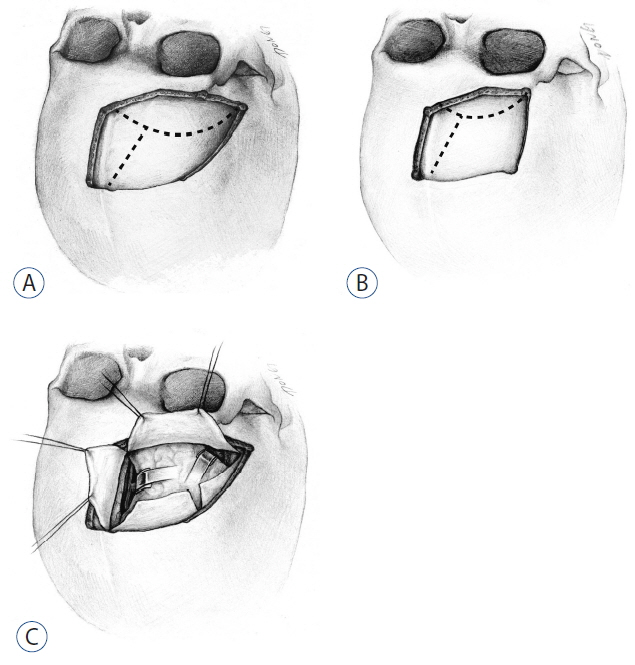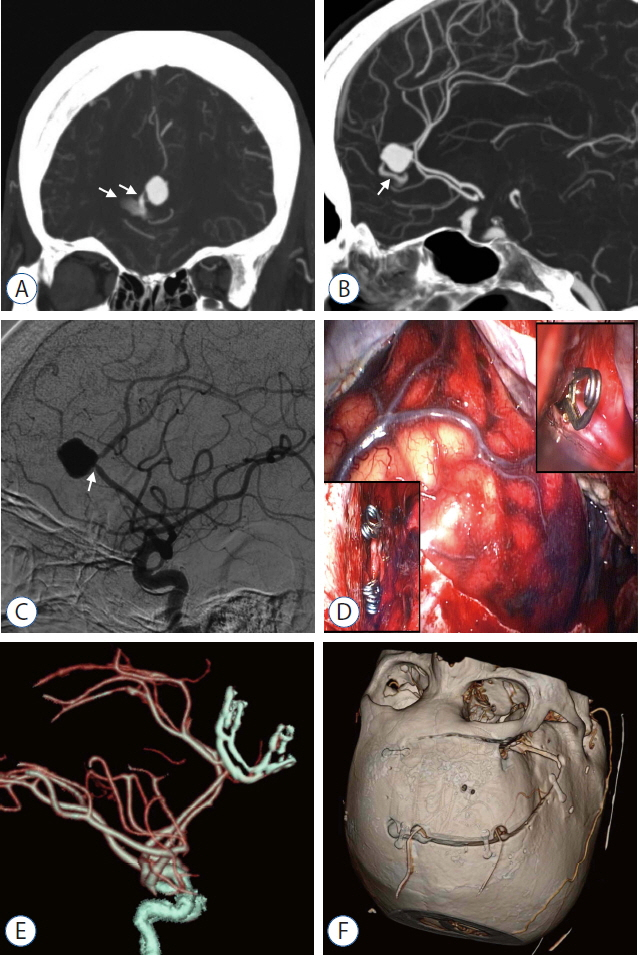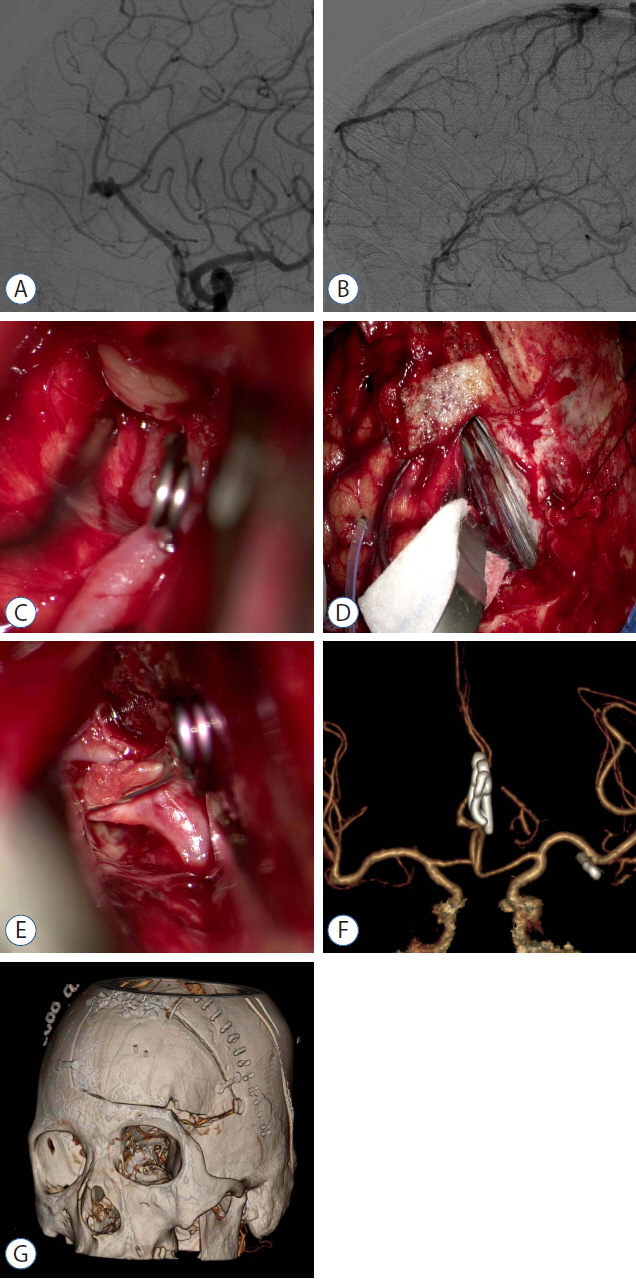J Korean Neurosurg Soc.
2017 Feb;60(2):250-256. 10.3340/jkns.2016.0910.009.
Pterional or Subfrontal Access for Proximal Vascular Control in Anterior Interhemispheric Approach for Ruptured Pericallosal Artery Aneurysms at Risk of Premature Rupture
- Affiliations
-
- 1Department of Neurosurgery, Research Center for Neurosurgical Robotic Systems, Kyungpook National University, Daegu, Korea. jparkmd@hotmail.com
- KMID: 2374888
- DOI: http://doi.org/10.3340/jkns.2016.0910.009
Abstract
OBJECTIVE
Cases of a ruptured pericallosal artery aneurysm with a high risk of intraoperative premature rupture and technical difficulties for proximal vascular control require a technique for the early and safe establishment of proximal vascular control.
METHODS
A combined pterional or subfrontal approach exposes the bilateral A1 segments or the origin of the ipsilateral A2 segment of the anterior cerebral artery (ACA) for proximal vascular control. Proximal control far from the ruptured aneurysm facilitates tentative clipping of the rupture point of the aneurysm without a catastrophic premature rupture. The proximal control is then switched to the pericallosal artery just proximal to the aneurysm and its intermittent clipping facilitates complete aneurysm dissection and neck clipping.
RESULTS
Three such cases are reported: a ruptured pericallosal artery aneurysm with a contained leak of the contrast from the proximal side of the aneurysm, a low-lying ruptured pericallosal artery aneurysm with irregularities on its proximal wall, and a multilobulated ruptured pericallosal artery aneurysm with the parasagittal bridging veins hindering surgical access to the proximal parent artery. In each case, the proposed combined pterional-interhemispheric or subfrontal-interhemispheric approach was successfully performed to establish proximal vascular control far from the ruptured aneurysm and facilitated aneurysm clipping via the interhemispheric approach.
CONCLUSION
When using an anterior interhemispheric approach for a ruptured pericallosal artery aneurysm with a high risk of premature rupture, a pterional or subfrontal approach can be combined to establish early proximal vascular control at the bilateral A1 segments or the origin of the A2 segment.
Keyword
MeSH Terms
Figure
Reference
-
References
1. de Sousa AA, Dantas FL, de Cardoso GT, Costa BS. Distal anterior cerebral artery aneurysms. Surg Neurol. 52:128–135. discussion 135–136. 1999.
Article2. Ducruet AF, Connolly ES Jr. Microsurgery of distal anterior cerebral artery aneurysms. Winn HR, editor. Youmans Neurological Surgery. ed 6. Elsevier Saunders;Philadelphia: 2011. p. 3853–3861.
Article3. Edner G. One-session operation via bilateral craniotomies for multiple aneurysms after subarachnoid haemorrhage. Br J Neurosurg. 5:55–60. 1991.
Article4. Elhammady MS, Nakaji P, Farhat H, Morcos JJ, Aziz-Sultan MA. Balloon-assisted clipping of a large paraclinoidal aneurysm: a salvage procedure. Neurosurgery. 65:E1210–E1211. discussion E1211. 2009.5. Kawashima M, Matsushima T, Sasaki T. Surgical strategy for distal anterior cerebral artery aneurysms: microsurgical anatomy. J Neurosurg. 99:517–525. 2003.
Article6. Kiyofuji S, Inoue T, Tamura A, Saito I. Combined interhemispheric and pterional approach for ACOM and left MCA aneurysms. Neurosurg Focus. 38(Video Suppl 1):Video 15. 2015.
Article7. Lawton MT. Seven aneurysms: tenets and techniques for clipping. Thieme Medical Publishers, Inc;New York: 2011. p. 147–163.8. Lee JW, Lee KC, Kim YB, Huh SK. Surgery for distal anterior cerebral artery aneurysms. Surg Neurol. 70:153–159. discussion 159. 2008.
Article9. Martines F, Blundo C, Chiappetta F. Surgical treatment of the distal anterior cerebral artery aneurysms. J Neurosurg Sci. 40:189–194. 1996.10. Mizoi K, Takahashi A, Yoshimoto T, Fujiwara S, Koshu K. Combined endovascular and neurosurgical approach for paraclinoid internal carotid artery aneurysms. Neurosurgery. 33:986–992. 1993.
Article11. Mizoi K, Yoshimoto T, Takahashi A, Ogawa A. Direct clipping of basilar trunk aneurysms using temporary balloon occlusion. J Neurosurg. 80:230–236. 1994.
Article12. Navarro R, Chao K, Steinberg GK. Microsurgical management of distal anterior cerebral artery aneurysms: from basic to complex, a video review of four cases. Acta Neurochir (Wien). 155:2115–2119. 2013.
Article13. Ng PY, Huddle D, Gunel M, Awad IA. Intraoperative endovascular treatment as an adjunct to microsurgical clipping of paraclinoid aneurysms. J Neurosurg. 93:554–560. 2000.
Article14. Paine JT, Batjer HH, Samson D. Intraoperative ventricular puncture. Neurosurgery. 22(6 Pt 1):1107–1109. 1988.
Article15. Park J, Hamm IS. Anterior interhemispheric approach for distal anterior cerebral artery aneurysm surgery: preoperative analysis of the venous anatomy can help to avoid venous infarction. Acta Neurochir (Wien). 146:973–977. discussion 977. 2004.
Article16. Park J, Hamm IS. Revision of Paine’s technique for intraoperative ventricular puncture. Surg Neurol. 70:503–508. discussion 977. 2008.
Article17. Proust F, Toussaint P, Hannequin D, Rabenenoïna C, Le Gars D, Fréger P. Outcome in 43 patients with distal anterior cerebral artery aneurysms. Stroke. 28:2405–2409. 1997.
Article18. Srinivasan J, Getch CC, Chandler JP, Batjer HH. Intraoperative aneurysm rupture. Le Roux PD, Winn HR, Newell DW, editors. Management of cerebral aneurysms. Saunders;Philadelphia: 2004. p. 867–874.19. Thorell W, Rasmussen P, Perl J, Masaryk T, Mayberg M. Balloon-assisted microvascular clipping of paraclinoid aneurysms. Technical note. J Neurosurg. 100:713–716. 2004.20. Yasargil MG, Reichman MV, Kubik S. Preservation of the frontotemporal branch of the facial nerve using the interfascial temporalis flap for pterional craniotomy. Technical article. J Neurosurg. 67:463–466. 1987.
- Full Text Links
- Actions
-
Cited
- CITED
-
- Close
- Share
- Similar articles
-
- Clinical Features of Distal Anterior Cerebral Artery Aneurysms Based on 26 Consecutive Cases
- Interhemispheric Approach for Intracranial Aneurysms
- Postoperative Clipping Status after a Pterional versus Interhemispheric Approach for High-Positioned Anterior Communicating Artery Aneurysms
- Microsurgical Treatment of Distal Anterior Cerebral Artery Aneurysm
- New Perspectives into the Combined Pterional and Interhemispheric Approach during Ruptured Anterior Communicating Artery Aneurysm Surgery in the Endovascular Treatment Era





